MCBees Use “Whodunit?” to Pique UHS Students’ Interest in Science During I-STEM Summer Camp
September 27, 2017
A grad student is dead. Who did it? An undergrad who wanted the grad student’s spot and/or funding? The professor who was upset with the student because he wasn't working hard enough in the lab?
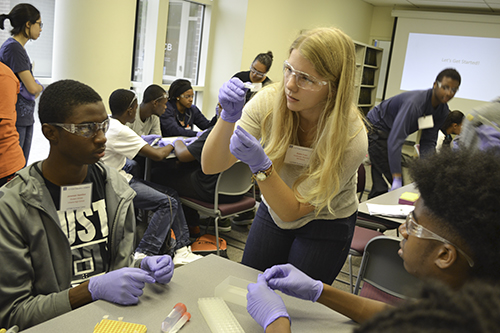
MCB PhD student Katie Frye words with a group of UHS students during a hands-on activity during the I-STEM Camp's MCB Day.
This “Whodunit?” was the scenario members of the MCBees came up with to get 27 Urbana High School (UHS) students excited about STEM, specifically DNA research. The MCBees, the MCB (School of Molecular and Cellular Biology) graduate student organization, provided the hands-on activities for day one of the first-ever, I-STEM Summer Camp, a multidisciplinary summer program from August 7–18, which focused on exposing underrepresented minorities to the many different STEM fields and career opportunities, building teamwork and lab skills in the students, and showing them what STEM research is like.
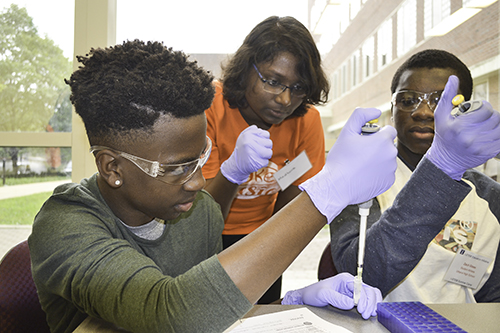
MCB grad student Madhura Duttagupta (center), teaches two UHS students how to use a pipette.
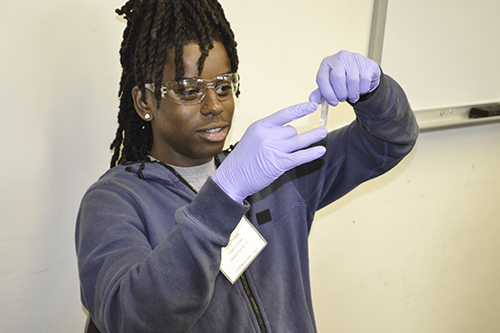
UHS student Tyran Pickett examines a sample containing some DNA.
To capture the students’ interest, the MCBees used the fun murder mystery scenario to structure their hands-on activities. Students were to use DNA research— similar to what’s done in forensic laboratories and to what many of them do day-in, day-out in the lab—to discover which of the two suspects did it.
The high schoolers were to take DNA samples from the crime scene, extract DNA from the cells found there, then perform a Polymerase Chain Reaction to amplify the part of the DNA that they were interested in, thus producing millions of copies of that DNA. Then they were to take that DNA and separated it on a gel, a thick jello-like substance that they could run the DNA through. Based on size, a different pattern would appear, that they would then need to match to the pattern found on the murder weapon.
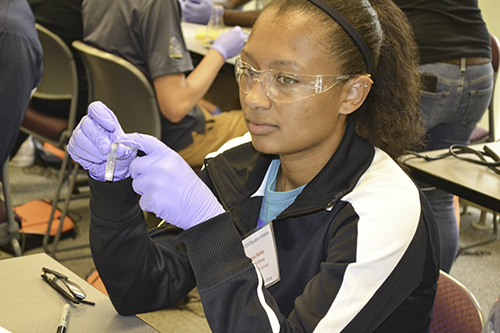
UHS student Amaya Bahler with her DNA sample.
The reason the MCBees chose this experiment, explains Outreach Coordinator Mara Livezey, is because it was a real research experience.
“It's like a real, start-to-finish experiment, and a lot of the techniques we use today are things that I use in lab every day. So this is a real research experience.”
She adds that it’s not until even further along in a student’s career where they’re taking something from start to finish and answering a question. “Something like this,” Livezey continues, “where they're really following an experiment from start to finish, is something that you don't get in high school. The first time you're really exposed to something like this is in undergrad, in maybe your biochemistry class.”
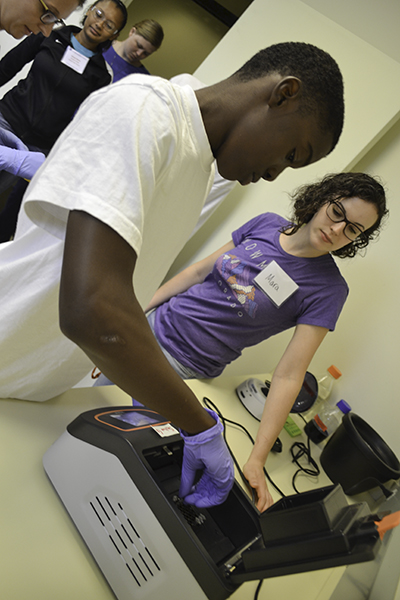
Mara Livezey (right) watches as a student places their sample in the equipment in order to perform a Polymerase Chain Reaction (PCR).
She hopes to expose them to the kinds of things scientists in her field do in hopes of piquing their interest in science. “I think something like this where we can make a fun scenario for the kids to follow along with is more interesting. It can maybe grab their excitement a little bit more and motivate them to maybe consider science in their future. I want them to have a real experience, like this is really what we do every day in lab. And if they can understand that, then maybe they'll be interested, hopefully.”
Another MCBee member, MCB Ph.D. student Paola Estrada, who’s majoring in biochemistry, participated in the camp because she enjoys working with students. Also, Estrada hopes to get them interested in science.
“I like to volunteer, do something else, get out of the lab,” she admits. “It seems like a good thing to get people into science, especially high school students.”
Her goal for the day? To expose the high school students to real science:
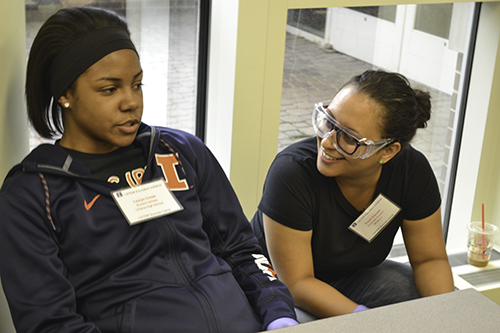
MCB PhD student Paola Estrada (right) chats with UHS student Lauryn Cross during the outreach.
“To get them interested a little bit, to see what it actually looks like. I feel like in high school, you do a lot of book stuff, and you think that maybe it's all not real. But I guess what we show here is actual, real science. What we're doing today, PCR gel electrophoresis, this is stuff that we do every day. Especially the way we're doing it, showing them a crime or how to solve the crime, it maybe makes it relevant or more interesting.”
Is this something that a forensic scientist would actually do?
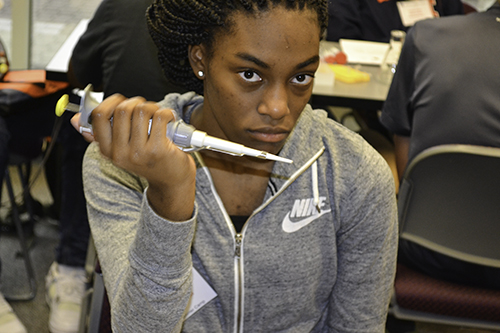
UHS student Akierra Bufford learning to use a pipette.
“Yes, definitely,” she says. She qualifies that in this activity, students were only looking at one aspect, whereas in the FBI, for instance, they usually look at maybe 13 different factors. Plus they use specialized software to compare the DNA to a whole database of DNA. “But it actually is stuff that forensic scientists use,” she says.
For Anshika Gupta, currently in the 2nd year of her MCB graduate program, this was her first time ever participating in such an event. She reports, “I was keen on seeing how enthusiastic are high schoolers about science, and if I can do anything to motivate them more...Also, I was keen on trying to explain science to someone who is not familiar with the kind of science terminology we scientists use. So, trying to explain them in ways which they could understand and correlate from their daily life, was something I was very excited to try my hand at.”
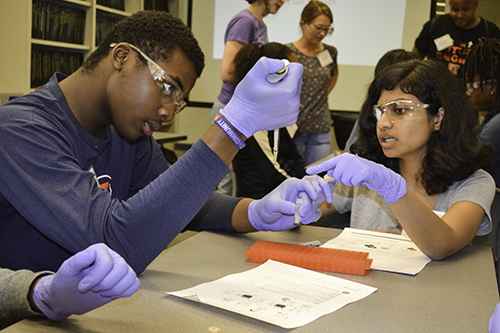
MCB grad student Anshika Gupta (right), instructs UHS student Sergio McClain on how to use a pipette.
Gupta, who works in Dr. James Imlay’s lab, is researching DNA repair enzymes important under oxidative stress, in particular, enzymes which play a major role in E.coli.
Gupta, who never got to see this part of biological sciences as a youngster, says these kinds of events “open up a vast world of opportunities for high schoolers.” She claims that in high school, she only saw a few anatomical structures of some animals more related to the field of medicine, which never interested her.
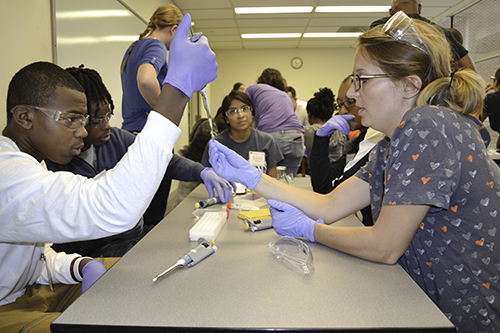
MCB grad student Kristen Farley (right) works with UHS student using a pipette to get a DNA sample.
“But there is a huge field of biology at the cellular level which no one taught us, which I find really interesting. Had someone exposed me to this branch of biology in high school, I might not have taken up engineering in college or explored much more about biology than learning its basics. But nevertheless, here I am, doing something which I really like. A practical experience like this makes it so much more interesting to learn something and know what people like the forensics actually do.”
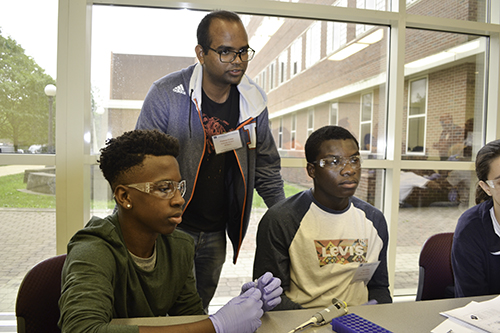
MCB grad student, Pradeep Kumar, works with a group of UHS students.
Regarding MCB Day's impact on the students, Gupta thinks most really enjoyed it. “These kinds of activities bring their curiosity out, which I could observe by the kind of questions they asked. I think in this playful game they ended up learning something new and cool which they wouldn’t have experienced otherwise.”
Jeremiah Heredia, a 4th-year MCB PhD student whose research is on how to develop a vaccine against HIV-1, says he participated in the I-STEM camp because he wanted to give back to the community. In fact, he got to where he is today because of a couple of similar programs, MARC and RISE, which train minority students for entering a PhD program.
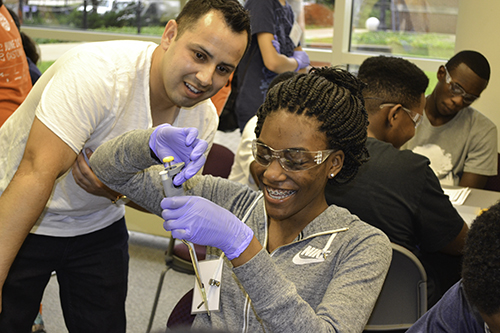
MCB grad student, Jeremiah Heredia, works with UHS student Akierra Bufford who is learning how to use pipette in order to do the DNA hands-on activity.
“I owe my career to these programs, because before I joined, I did not believe science was for me, because no scientist looked like me,”he acknowledges. I had this preconceived notion that research scientists were all just naturally gifted and that they did not like sports or to socialize. I wanted to show these students a different perspective of science than the one I had as a teen. I wanted to show that science is fun and, more importantly, meant for everyone.”
As a member of an underrepresented group in STEM, Heredia is cognizant of the importance of programs such as I-STEM’s camp, which can help steer minorities into the STEM pipeline.
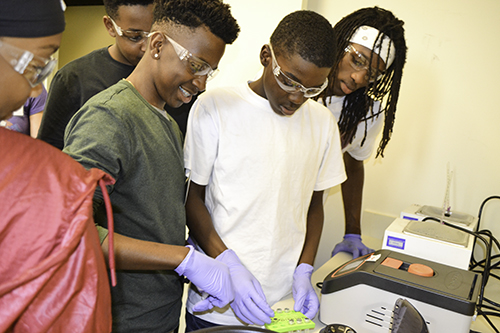
UHS students prepare to perform a Polymerase Chain Reaction.
“There are a lack of women and minorities in the science field,” he says. “It isn't because these groups are less capable of doing science; instead, it's simply that they are not exposed/ encouraged to do science. I-STEM’s camp is great because it exposes students to science while they are still in high school.”
Regarding the camp’s impact, Heredia says he tried to connect with the students and believes he might have gotten a few interested in science.
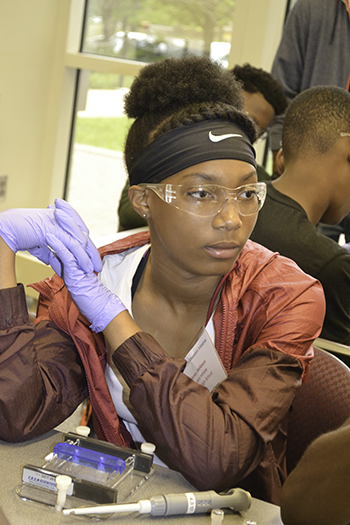
UHS student Alarea Jackson.
“I wanted to get to know the students. I asked them several questions about their goals, and I laughed with them. When I gave my 10-minute research talk about developing a vaccine against HIV-1, I had several questions from the students. I hope by doing all of this, I sparked an interest in the students, while at the same time making them feel comfortable with science.”
Rising sophomore, Alarea Jackson, who plays basketball at UHS, reports that she participated in the camp to learn more about science.
“Because I wanted to get a better knowledge on science and the stuff that we are doing, and hopefully it will help me with my high school studies and probably college.”
In light of her possible future career choice (Jackson hopes to become an anesthesiologist and to major in chemistry in college), the MCB’s lab activities were very apropos, and she gained some important skills: “I have never used a pipette before, and it was my first time using it.”
Who did she think did it? “I think the undergrad did it,” she admits.
Author/Photographer: Elizabeth Innes, Communications Specialist, I-STEM Education Initiative
More: 8-12 Outreach, I-STEM Initiatives, MCB, MCBees, STEM Pipeline, Summer Camp, Underserved Students/Minorities in STEM, Urbana High School, 2017
For additional articles about I-STEM's 2017 Summer Camp, see:
- I-STEM Multidisciplinary Summer Program Exposes UHS Athletes to Different STEM Departments/Units
- MNTL Day Exposes UHS Students to Nanotechnology Research During I-STEM’s Summer Multidisciplinary Camp
- Akono and Company Teach UHS Students About Civil Engineering and Strength of Materials During I-STEM’s Multidisciplinary Summer Camp
- ECE Day at I-STEM’s Multidisciplinary Summer Camp: Soldering, Circuits, and Software
- Math Day at I-STEM’s Multidisciplinary Summer Camp Adds Up to Fun
- During I-STEM Summer Camp, Urbana High School Students’ Understanding of Aerospace Engineering Soars
- UHS Students Explore Computer Science, Coding, During I-STEM Camp’s CS Day
- At I-STEM's Multidisciplinary Summer Camp, UHS Students Have Fun with Chemistry—Everything From Soap Making To Glow Sticks to Ice Cream
- UHS Students Gear Up for Mechanical Science and Engineering During I-STEM Summer Camp
- During I-STEM Camp’s NCSA Day, UHS Students Experience Data Visualization, Super Computers, and NCSA’s Research
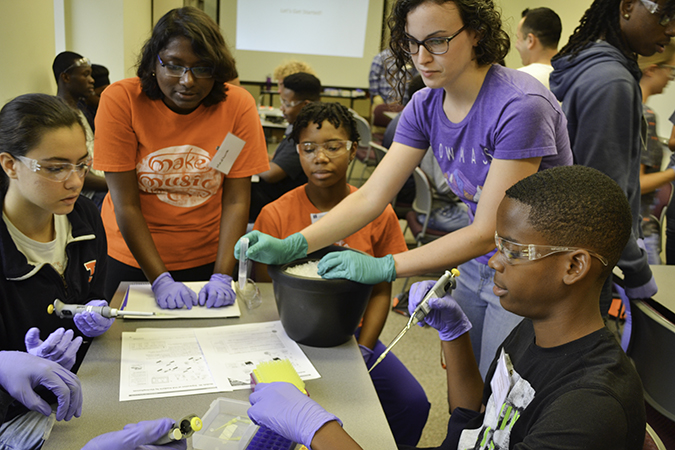 Madhura Duttagupta and Mara Livezey give UHS students samples to use during their DNA research.
Madhura Duttagupta and Mara Livezey give UHS students samples to use during their DNA research.












.jpg)
















